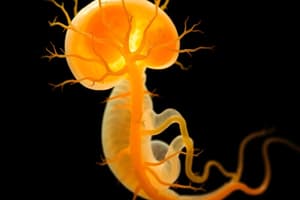Podcast
Questions and Answers
What is the most common risk factor associated with spina bifida?
What is the most common risk factor associated with spina bifida?
- Folate deficiency (correct)
- Exposure to high altitudes
- Viral infections
- Alcohol consumption during pregnancy
What is the primary method of transmission for the Zika virus?
What is the primary method of transmission for the Zika virus?
- Contaminated water sources
- Airborne particles
- Aedes aegypti mosquito bites (correct)
- Direct contact with infected individuals
Which form of spina bifida is considered the most severe?
Which form of spina bifida is considered the most severe?
- Encephalocele
- Myelomeningocele (correct)
- Meningocele
- Spina bifida occulta
During the Zika virus epidemic, what significant issue was linked to the infection during pregnancy?
During the Zika virus epidemic, what significant issue was linked to the infection during pregnancy?
What is the current understanding of the cause of spina bifida?
What is the current understanding of the cause of spina bifida?
What is the primary result of neurulation during embryonic development?
What is the primary result of neurulation during embryonic development?
At what point in embryonic development does the process of neurulation initiate?
At what point in embryonic development does the process of neurulation initiate?
Which of the following describes the tissue that forms the central and peripheral nervous systems?
Which of the following describes the tissue that forms the central and peripheral nervous systems?
What characterizes the transformation of the ectoderm during neural induction?
What characterizes the transformation of the ectoderm during neural induction?
What is a significant structural change that occurs as the primitive streak regresses?
What is a significant structural change that occurs as the primitive streak regresses?
What is the primary role of chordamesoderm during gastrulation?
What is the primary role of chordamesoderm during gastrulation?
What process occurs to the chordamesoderm as the primitive streak regresses?
What process occurs to the chordamesoderm as the primitive streak regresses?
What is the significance of the notochord during neural induction?
What is the significance of the notochord during neural induction?
What cellular structure changes shape during neurulation to form bottle cells?
What cellular structure changes shape during neurulation to form bottle cells?
What is the outcome if microtubule formation is inhibited during neurulation?
What is the outcome if microtubule formation is inhibited during neurulation?
What happens to the anterior and posterior neuropores during neural tube formation?
What happens to the anterior and posterior neuropores during neural tube formation?
What condition results from the failure of anterior neuropore closure?
What condition results from the failure of anterior neuropore closure?
What is the effect of Noggin and Chordin during neural plate formation?
What is the effect of Noggin and Chordin during neural plate formation?
Which structure originates from the neural tube during development?
Which structure originates from the neural tube during development?
What molecular event blocks the induction of epidermal fate during the formation of the neural plate?
What molecular event blocks the induction of epidermal fate during the formation of the neural plate?
Which agent disrupts actin microfilaments during neurulation?
Which agent disrupts actin microfilaments during neurulation?
What is the result of the improper closure of the posterior neuropore?
What is the result of the improper closure of the posterior neuropore?
What are neural folds responsible for during the neurulation process?
What are neural folds responsible for during the neurulation process?
What structure changes to form the neural tube?
What structure changes to form the neural tube?
Flashcards
Spina Bifida Occulta
Spina Bifida Occulta
The mildest form of spina bifida with a small gap in the spine bones.
Spina Bifida Aperta
Spina Bifida Aperta
An open form of spina bifida, includes meningocele and myelomeningocele.
Folate Deficiency
Folate Deficiency
Insufficient folate can increase the risk of spina bifida.
Zika Virus Epidemic
Zika Virus Epidemic
Signup and view all the flashcards
Microcephaly
Microcephaly
Signup and view all the flashcards
Neural Plate
Neural Plate
Signup and view all the flashcards
Neuroectoderm
Neuroectoderm
Signup and view all the flashcards
Induction
Induction
Signup and view all the flashcards
Neural Tube
Neural Tube
Signup and view all the flashcards
Neurulation
Neurulation
Signup and view all the flashcards
Germ Layers
Germ Layers
Signup and view all the flashcards
Chordamesoderm
Chordamesoderm
Signup and view all the flashcards
Notochord
Notochord
Signup and view all the flashcards
Neural Induction
Neural Induction
Signup and view all the flashcards
Neural Crest Cells
Neural Crest Cells
Signup and view all the flashcards
Bottle Cells
Bottle Cells
Signup and view all the flashcards
Anterior Neuropore
Anterior Neuropore
Signup and view all the flashcards
Posterior Neuropore
Posterior Neuropore
Signup and view all the flashcards
Neural Tube Defects
Neural Tube Defects
Signup and view all the flashcards
Anencephaly
Anencephaly
Signup and view all the flashcards
Spina Bifida
Spina Bifida
Signup and view all the flashcards
Noggin and Chordin
Noggin and Chordin
Signup and view all the flashcards
Study Notes
Embryonic Development of the Nervous System
- Neural Plate: A thickened region of the ectoderm, precursor to the neural tube which forms the CNS.
- Neuroectoderm: The embryonic tissue giving rise to the nervous system (both CNS and PNS)
- Induction: A process where one group of cells influences another's development through signaling molecules.
- Neural Tube: The structure arising from the neural plate which forms the brain and spinal cord (CNS).
- Neurulation: The transformation of the neural plate into a neural tube; starts CNS development and indirectly impacts Peripheral Nervous System (PNS) formation. Initiated around week 3.
Primitive Streak Regression
- The primitive streak, a structure involved in gastrulation, gradually regresses during neurulation.
- As the streak moves cranially, it leaves a trail of notochordal precursor cells behind.
- The regression process creates the neural plate from the ectoderm.
- The ectoderm now differentiates into surface ectoderm and neural ectoderm.
Neural Induction
- Chordamesoderm, a mesodermal precursor of the notochord, is key to neural induction.
- Signaling molecules from the chordamesoderm influence the ectoderm, causing it to become a neural ectoderm and form the neural plate.
- Critical aspects include influencing the ectoderm to adopt a "neural fate" and inhibiting epidermal development.
- Signaling molecules like Noggin and Chordin regulate this process by inhibiting BMP-4, crucial for development pathways.
Neurulation Events
- Neural Groove and Folds: The neural plate begins to develop a groove, which then folds to create neural folds, important steps in the neurulation process.
- Tube Formation: Neural folds meet together and fuse to generate the neural tube; which overlies the ectoderm.
- Neural Crest Cells: During neural tube formation, neural crest cells, which contribute to the PNS, develop.
- Neuropore Closure: The neural tube closes in two places- Anterior and Posterior neuropores.
- Molecular Mechanisms: Molecular signals from the notochord guide the formation and closure of the neural tube.
Impact of Cell Structure
- Bottle Cells: These cells exhibit specific cytoskeletal characteristics (microfilaments and microtubules) essential for the tube formation process; particularly during the neurulation stage
- disruption of either microfilaments or microtubules will interrupt neurulation.
- Inhibitors (e.g., Colchicine and Cytochalasin D): Disrupting cell cytoskeletons, for example via specific drugs, can affect neurulation.
Neural Tube Defects
- Errors in Closure: Defects in the closure of the neural tube lead to a variety of severe birth defects, including anencephaly and spina bifida.
- Anencephaly: Failure of the anterior neuropore to close, resulting in severe brain malformation. Usually leading to death prior to birth or shortly after.
- Spina Bifida: Failure of the posterior neuropore to close; varying in severity, from occulta to more serious forms like myelomeningocele, affecting the spinal cord.
- Risk Factors: Folate deficiency, genetics, and other environmental factors can increase the risk of neural tube defects.
- Treatment & Prevention: Treatment options (surgical) exist and prevention through sufficient folic acid intake is crucial.
Zika Virus and Congenital Defects
- Zika Virus: The Zika virus, spread by mosquitoes, can be passed from pregnant women to their fetuses.
- Microcephaly: A significant association between Zika virus infection and microcephaly– a birth defect characterized by a smaller than normal head size and possible brain damage in babies.
Studying That Suits You
Use AI to generate personalized quizzes and flashcards to suit your learning preferences.



